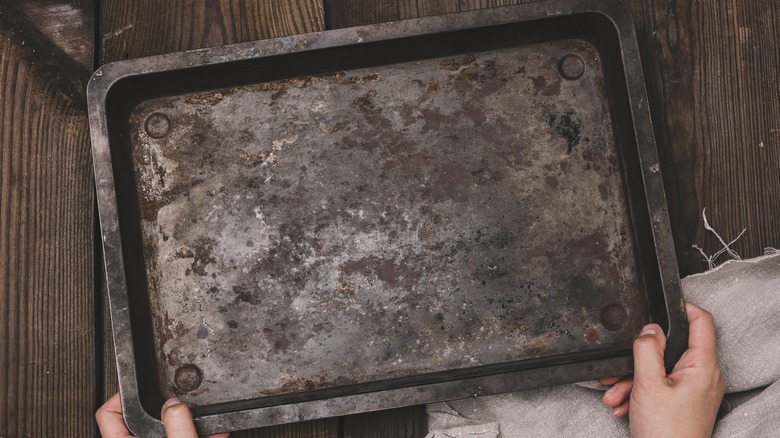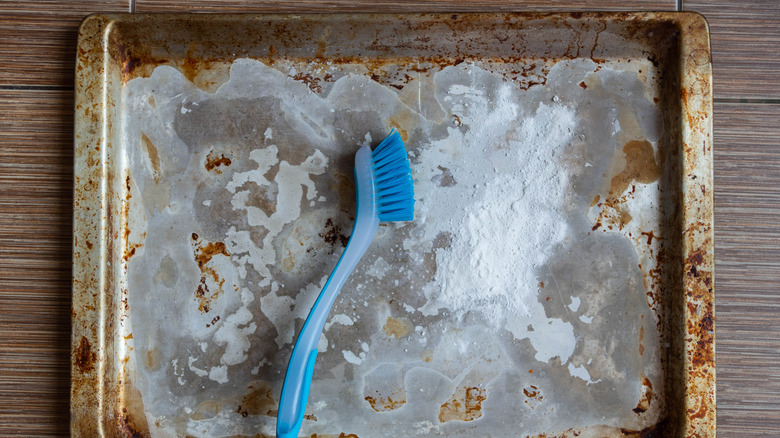Easily Clean Burnt Baking Sheets With A Handy Tool You Likely Already Own
We've all been guilty of forgetting to grease a baking sheet, and after 30 minutes at 350 degrees Fahrenheit, you're left with a stuck-on mess that has ruined your culinary pursuit and left your pan covered with burnt-on food. When exposed to high temperatures, food particles like sugars can adhere to the surface of the baking sheet if it isn't properly greased first. Over time, your baking sheet may develop hardened debris that inevitably becomes more difficult to remove with each subsequent pan use. As a result, you may even toss the pan and replace it. Before doing so, there is one trick you ought to try that can easily resurrect the shine on your baking sheets: try using a razor blade to scrape off the baked-on food.
A razor blade is an unsuspecting tool that can surprisingly make removing burnt-on food from your favorite baking sheet super simple. Unlike other cleaning tools like a sponge or a scrubber that may lack the force to dislodge difficult debris, a razor blade can quickly scrape away stubborn residue without excessive force. In this way, you can also preserve the integrity of your pan, as deep scrubbing with an inadequate tool can damage its surface. The flat, thin nature of a razor blade also allows it to scrape food from tight crevices, ensuring your pan is as good as new. Try this method before replacing your seasoned pan with a new one.
How to use a razor blade on your baking sheets
If you're ready to scrape that hardened grime from your baking sheet for good, grab a new razor blade with a sharp edge to get started. It's a good idea to give it some leverage by soaking your pan first. Place your baking sheet in a sink of dish soap and hot water, and allow it to soak for at least 30 minutes to help loosen some of the debris caked onto your pan. For an added bonus, you could sprinkle baking soda over the particularly grimy areas of the pan. The baking soda acts as an all-natural abrasive, helping to tackle tougher spots on the baking sheet. It may also save your baking sheets from rust.
After soaking, dump out the water and place the sheet on a stable flat surface. Putting a dish rag underneath it will prevent it from slipping while you work. Next, hold the razor blade securely between your thumb and index finger, avoiding the sharp edge. Gently scrape small sections of the pan at a shallow angle to gradually lift off the burnt material. Don't push too hard, as you may unintentionally damage the pan's surface. As you work, wipe away any loosened food particles with a damp cloth or sponge and assess your progress as you go. Proceed until you remove all the food, and then wash the baking sheet in warm, soapy water to rinse away any remaining debris.
Cautions for this method
While a razor blade is a simple and effective tool for removing caked-on debris from your baking sheet, it's a good idea to approach this method cautiously. A razor blade is an incredibly sharp tool, so be sure you have clean, dry hands before using it to prevent slipping or cutting yourself. To further protect your hands, it may be a good idea to wear protective gloves. Moreover, using a clean, fresh blade will make this process easier, while using a dull or damaged blade may cause injury to you or your baking sheet. Keep your fingers from the sharp edge while handling the blade.
Another thing to remember about this method is that a razor blade may be too sharp for certain types of pans. Nonstick or coated baking sheets shouldn't be cleaned with a razor blade as they have delicate coatings. A razor blade will likely scrape away this surface, exposing the underlying metal to corrosion or rust while reducing its nonstick properties. Instead, these pans should be soaked and cleaned with a gentler tool such as a plastic or nylon scraper or sponge. Additionally, using a paste made of baking soda and vinegar may help lift stubborn debris from your nonstick pans. Allow this paste to sit on the pan for at least 30 minutes or overnight for severe burns. Gently scrubbing away the paste after soaking should help to cut through stubborn stains.

